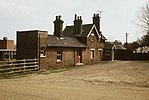London Luton Airport (IATA: LTN, ICAO: EGGW) is an international airport located in Luton, Bedfordshire, England, situated 1.7 miles (2.7 km) east of the town centre, and 35 miles (56 km) north of Central London. The airport is owned by London Luton Airport Ltd (LLAL), a company wholly owned by Luton Borough Council, and operated by London Luton Airport Operations Ltd (LLAOL).An airport was opened on the site on 16 July 1938. During the Second World War, the airport was used by fighters of the Royal Air Force. Commercial activity and general aviation flight training at Luton resumed during 1952. By the 1960s, Luton Airport was playing a key role in the development of the package holiday business; by 1969, a fifth of all holiday flights from the UK departed from Luton Airport. From the mid-1960s, executive aircraft have been based at the airport. During the late 1970s, an expansion plan was initiated at Luton to accommodate as many as 5 million passengers per year, although the airport experienced a reduction in passenger numbers in the 1980s. In 1990, the airport was renamed London Luton Airport to try and emphasise the airport's proximity to the capital.
The arrival of new operators at Luton during the 1990s, such as charter operator MyTravel Group and new low-cost scheduled flights from Debonair and EasyJet, contributed to a rapid increase in passenger numbers that made it the fastest growing major airport in the UK. In August 1997, to fund an £80 million extension of the airport, a 30-year concession contract was issued to a public-private partnership consortium, London Luton Airport Operations Limited. Throughout the 1990s, £30 million was invested in Luton's infrastructure and facilities. In November 1999, a new £40 million terminal was opened by Queen Elizabeth II and Prince Philip; the new building houses 60 check-in desks, baggage and flight information systems and a range of commercial outlets. During 2004/5, the departure and arrivals lounges and other facilities were redeveloped at a cost of £38 million.
In 2018, over 16.5 million passengers passed through the airport, a record total for Luton making it the fifth
busiest airport in the UK. It is the fourth-largest airport serving the London area after Heathrow, Gatwick and Stansted, and is one of London's six international airports along with London City and Southend. The airport serves as a base for easyJet, TUI Airways, Ryanair and Wizz Air and previously served as a base for Monarch Airlines until it ceased operations in October 2017. The vast majority of the routes served are within Europe, although there are some charter and scheduled routes to destinations in Northern Africa and Asia.






